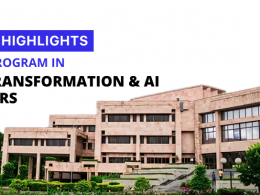In the digital age, where data has become the lifeblood of businesses, cloud computing has emerged as a transformative technology that has revolutionized the way we store, access, and manage information.
With its unparalleled scalability, flexibility, and cost-efficiency, cloud computing has become an integral part of modern businesses and our daily lives.
In this comprehensive blog, we will delve into the world of cloud computing, covering everything you need to know about this top-trending technology.
What is Cloud Computing?
Cloud computing refers to the delivery of computing services—including servers, storage, databases, networking, software, analytics, and intelligence—over the internet to offer faster innovation, flexible resources, and economies of scale. Instead of owning their own computing infrastructure or data centers, companies can rent access to anything from applications to storage from a cloud service provider.
The concept of cloud computing has evolved over time, starting from the days of mainframes and evolving into the highly distributed and interconnected systems we have today.
Types of Cloud Computing
- Infrastructure as a Service (IaaS): IaaS provides virtualized computing resources over the internet, offering the fundamental building blocks for IT. This includes virtual machines, storage, and networking.
- Platform as a Service (PaaS): PaaS offers an environment for application development and deployment. It includes tools for building, testing, and managing applications.
- Software as a Service (SaaS): SaaS delivers software applications over the internet on a subscription basis, eliminating the need for users to install, maintain, and update the software.
- Function as a Service (FaaS): FaaS, also known as serverless computing, allows developers to run code in response to events, scaling automatically with demand.
Cloud Deployment Models
1. Public Cloud
Services are delivered over the internet and shared by multiple organizations
- Shared Resources: Public cloud services are provided by third-party cloud service providers and are accessible to multiple organizations. These organizations share the same physical infrastructure, including servers, storage, and networking resources.
- Economies of Scale: Public cloud providers leverage economies of scale, offering cost-effective solutions because they distribute infrastructure costs among many clients. This model allows organizations to access state-of-the-art technology without large upfront investments.
- Self-Service: Public clouds typically offer self-service portals, enabling users to provision resources and services on-demand. This agility and accessibility make it a popular choice for startups, small businesses, and organizations with variable workloads.
- Mitigation: While public cloud offers cost-effective solutions and ease of access, organizations must consider data security, compliance, and privacy and choose suitable cloud providers and configurations to address these concerns.
2. Private Cloud
Dedicated cloud resources for a single organization, hosted either on-premises or by a third-party provider-
- Dedicated Resources: Private clouds are designed for a single organization and provide dedicated hardware and network resources. They offer greater control and customization compared to public cloud options.
- Security and Privacy: Private clouds are often chosen for their enhanced security and data privacy, as they are isolated from other organizations. This makes them a suitable choice for industries with strict compliance requirements, such as finance and healthcare.
- Hybrid Integration: Private clouds can be integrated with public clouds, creating a hybrid cloud environment that allows organizations to take advantage of the scalability and cost-efficiency of the public cloud while maintaining sensitive data in a private environment.
- Costs: Private clouds typically involve higher upfront costs due to dedicated infrastructure and maintenance. However, they may be cost-effective for organizations with specific compliance or security needs.
- Mitigation: Private clouds offer control and security, but organizations must still ensure proper data management and security measures within their private cloud environments.
3. Hybrid Cloud
Combines public and private cloud environments, allowing data and applications to be shared between them-
- Flexibility: Hybrid cloud environments offer organizations the flexibility to run workloads in the most appropriate location. They can leverage public cloud resources for scalability and cost-efficiency, while keeping sensitive or mission-critical data in a private cloud.
- Data Portability: Hybrid clouds enable the seamless transfer of data and applications between public and private environments, making it easier to meet changing business needs.
- Cost Optimization: Organizations can achieve cost savings by using public cloud resources for variable workloads and private cloud resources for stable, sensitive workloads.
- Complexity: Managing a hybrid cloud can be more complex than using one cloud model. Organizations need a solid strategy to effectively integrate and manage both environments.
- Mitigation: Organizations should establish a clear hybrid cloud strategy, including data management policies, security controls, and application integration plans to maximize the benefits of both public and private clouds.
4. Community Cloud
Shared infrastructure for a specific community, such as government or healthcare organizations-
- Shared Resources: Community clouds are designed to serve a specific group of organizations or communities with common interests or compliance requirements. They share the same cloud infrastructure and services.
- Data Privacy: Community clouds are often chosen by organizations with similar data privacy and security needs, such as government agencies or healthcare providers. They can provide a higher level of data control and compliance than public clouds.
- Collaboration: Community clouds encourage collaboration and resource sharing among member organizations while still providing a degree of data isolation and privacy.
- Mitigation: Organizations using community clouds must ensure that the shared infrastructure aligns with their specific compliance and security requirements and that proper data access controls are in place.
Benefits of Cloud Computing
1. Cost Savings
Cloud computing can significantly reduce capital expenditure on hardware and maintenance costs-
- No Upfront Hardware Costs: Cloud services eliminate the need for organizations to invest in and maintain expensive on-premises hardware, such as servers and data centers. This reduces the initial capital expenses associated with infrastructure.
- Pay-as-You-Go Pricing: Many cloud providers offer a pay-as-you-go pricing model, allowing organizations to pay only for the resources and services they actually use. This cost-efficiency reduces the risk of over-provisioning and wastage.
- Reduced Maintenance Costs: Cloud providers handle hardware maintenance, updates, and security, relieving organizations of the associated operational costs.
- Mitigation: While cloud services offer cost savings, it’s crucial for organizations to monitor and manage their cloud spending to prevent unexpected overages.
2. Scalability and Flexibility
Cloud resources can be scaled up or down on-demand, allowing businesses to adapt quickly to changing needs-
- Resource Elasticity: Cloud computing allows organizations to dynamically adjust the amount of computing resources, storage, and services they use to match their current requirements. This flexibility supports both planned growth and unexpected spikes in demand.
- Agility: Rapid scaling and provisioning of resources enable organizations to respond swiftly to market changes and emerging opportunities.
- Global Reach: Cloud providers often have data centers in multiple geographic locations, allowing businesses to expand into new regions without investing in local infrastructure.
- Mitigation: Proper resource management is essential to ensure that organizations can efficiently scale up and down without incurring unnecessary costs.
3. Disaster Recovery
Cloud providers often offer robust disaster recovery solutions, ensuring data is safe and accessible even in the face of unexpected events-
- Data Redundancy: Cloud providers replicate data across multiple data centers, ensuring data redundancy and minimizing the risk of data loss due to hardware failures or disasters.
- Automatic Backups: Many cloud services offer automated backup and recovery features, simplifying the process of data recovery in the event of data corruption or loss.
- Business Continuity: Cloud-based disaster recovery solutions enable businesses to quickly resume operations in case of system failures or catastrophic events, reducing downtime and revenue loss.
- Mitigation: Organizations must have a disaster recovery plan in place that accounts for both data and application recovery. Regular testing and documentation of the plan are crucial.
4. Accessibility
Cloud services can be accessed from anywhere with an internet connection, making remote work and collaboration easier-
- Remote Work: Cloud computing supports remote work by allowing employees to access their work environments and data from any location with internet access.
- Collaboration: Cloud-based collaboration tools and applications enable teams to work together in real-time, regardless of their physical locations.
- Accessibility: Cloud services can be accessed from a variety of devices, including laptops, smartphones, and tablets, providing users with flexibility and accessibility.
- Mitigation: While accessibility is a significant advantage, organizations should ensure data security and compliance with data privacy regulations when employees access cloud resources remotely.
5. Security
Cloud providers invest heavily in security measures, offering features like encryption, multi-factor authentication, and regular security updates-
- Data Encryption: Cloud providers often offer robust encryption for data in transit and at rest, safeguarding it from unauthorized access.
- Multi-Factor Authentication (MFA): MFA adds an additional layer of security by requiring users to provide multiple forms of authentication, such as a password and a one-time code sent to their mobile device.
- Security Updates: Cloud providers regularly update and patch their systems to address vulnerabilities and emerging security threats.
- Compliance: Cloud providers often adhere to industry-specific compliance standards, making it easier for organizations to meet regulatory requirements.
- Mitigation: While cloud providers invest in security, organizations must also take responsibility for securing their data and systems through robust access controls, user training, and continuous security monitoring.
Components of Cloud Security
1. Data Encryption
Protecting data through encryption is a critical security measure-
- Data at Rest: Encryption is used to protect data when it’s stored on cloud servers (data at rest). Even if an unauthorized party gains access to the physical servers, they won’t be able to decipher the encrypted data without the encryption keys.
- Data in Transit: Encryption is also used to secure data as it travels between the user’s device and the cloud servers (data in transit). This prevents interception and eavesdropping during data transfer.
- End-to-end Encryption: Implementing end-to-end encryption ensures that data remains encrypted from the moment it’s generated until it’s decrypted by the intended recipient, reducing the risk of data exposure.
- Mitigation: Organizations should select cloud providers that offer robust encryption mechanisms and, when necessary, manage their encryption keys securely. They should also encrypt sensitive data within their applications and follow encryption best practices.
2. Access Control
Proper access management ensures only authorized users can access resources-
- Authentication: Strong authentication mechanisms, such as two-factor authentication (2FA) and biometrics, verify the identity of users and devices attempting to access cloud resources.
- Authorization: After authentication, access control mechanisms determine what resources and data the authenticated user or system is allowed to access. Role-based access control (RBAC) is a common method for managing authorization.
- Least Privilege: The principle of least privilege ensures that users and systems have only the minimum level of access required to perform their tasks. This minimizes the risk of unauthorized access.
- Mitigation: Organizations should implement robust access control policies, regularly review and update permissions, and enforce strong authentication methods. Regular audits and monitoring can help detect and respond to unauthorized access attempts.
3. Compliance and Regulations
Understanding and adhering to industry-specific regulations is essential-
- Data Protection Regulations: Different industries and regions have specific data protection regulations and compliance requirements. For instance, GDPR in Europe, HIPAA in healthcare, and PCI DSS in the payment card industry.
- Data Residency Laws: Some countries require data to be stored within their borders, which can impact where and how data is stored in the cloud.
- Audit and Reporting: Many regulations necessitate regular audits, reporting, and documentation of security practices to ensure compliance.
- Mitigation: Organizations must thoroughly understand the regulations that apply to their industry and region. They should implement policies and practices that align with these regulations, engage legal counsel if necessary, and establish mechanisms for compliance reporting and audits.
4. Security Best Practices
Implementing best practices such as regular updates, intrusion detection, and threat monitoring is crucial-
- Regular Updates: Keeping software and systems up-to-date with the latest security patches and updates is essential to protect against known vulnerabilities.
- Intrusion Detection: Implementing intrusion detection systems (IDS) and intrusion prevention systems (IPS) can help identify and respond to suspicious activities.
- Threat Monitoring: Continuously monitoring for security threats and anomalies in network and application traffic allows for timely response to potential security breaches.
- Security Training: Training employees and users in security best practices is crucial, as many security breaches result from human error.
- Mitigation: Organizations should establish a robust patch management process, implement security monitoring and alerting systems, conduct regular security training, and develop an incident response plan to address security incidents promptly.
Challenges and Concerns associated with Cloud Computing
1. Data Privacy
Storing data on the cloud can raise concerns about data privacy and ownership-
- Data Privacy Concerns: When you store data on the cloud, you entrust a third-party provider with your sensitive information. This raises concerns about data privacy, as you may not have complete control over the data and its access. Many countries have strict data protection regulations, and businesses must ensure compliance with these laws.
- Ownership and Control: Cloud service providers often have terms of service that can impact data ownership and control. You must understand the terms and conditions related to your data and ensure they align with your organization’s data ownership policies.
- Mitigation: To address data privacy concerns, it’s crucial to encrypt data both in transit and at rest, implement access controls, and choose cloud providers that adhere to stringent security and compliance standards. It’s also important to conduct regular security audits and risk assessments to ensure data privacy is maintained.
2. Downtime and Reliability
Dependence on cloud providers can lead to downtime in case of service outages-
- Downtime: Cloud service providers are not immune to service outages. These outages can result from technical glitches, maintenance, or cyberattacks. Organizations dependent on cloud services may experience downtime, which can disrupt their operations and lead to financial losses.
- Reliability Concerns: While major cloud providers strive for high reliability and redundancy, no system is completely immune to downtime. The reliability of cloud services can be affected by issues such as network problems, hardware failures, and even natural disasters.
- Mitigation: To mitigate downtime risks, organizations can implement redundancy by using multiple cloud providers or a hybrid cloud approach. They can also use load balancing and failover mechanisms to redirect traffic in case of service interruptions. Additionally, it’s crucial to have a robust disaster recovery and business continuity plan in place.
3. Vendor Lock-in
Transferring data and applications between cloud providers can be challenging-
- Vendor-Specific Technologies: Cloud providers often offer proprietary technologies and services that can make it difficult to migrate data and applications to a different provider. This is known as vendor lock-in.
- Portability Challenges: Transferring applications and data from one cloud provider to another can be complex and costly. The need for reconfiguration, data transformation, and code rewriting can be a significant barrier.
- Mitigation: To mitigate vendor lock-in, organizations should design applications to be as platform-agnostic as possible, relying on open standards and containers. They can also negotiate clear terms in service-level agreements (SLAs) to ensure data portability and provide for an exit strategy.
4. Cost Management
Without proper monitoring, cloud costs can spiral out of control-
- Pricing Complexity: Cloud pricing models can be intricate, with numerous variables that affect costs, such as data transfer, storage, compute instances, and services. Without careful monitoring, it’s easy for costs to escalate.
- Resource Overprovisioning: Organizations may overprovision resources, thinking it’s safer to have more than they need. This can lead to unnecessarily high costs.
- Monitoring and Optimization: Effective cost management requires continuous monitoring of cloud resource usage. This can involve setting up alerts, rightsizing resources, and optimizing the selection of cloud services to match the specific needs of an organization.
- Mitigation: To control cloud costs, organizations should implement cloud cost management tools, allocate resources effectively, set budgets, and establish cost control policies. Regularly reviewing cloud bills and usage data is essential to ensure cost optimization.
Future Trends in Cloud Computing
1. Edge Computing
Edge computing is a paradigm shift that’s gaining momentum in the world of cloud computing. The concept revolves around processing data as close as possible to its source, often at the edge of the network, rather than relying on a centralized data center.
This approach is motivated by the need to reduce latency, improve real-time responsiveness, and enhance the overall efficiency of data processing.
- Latency Reduction: By processing data closer to where it’s generated, edge computing significantly reduces the time it takes for data to travel to a remote data center and back. This is especially critical for applications requiring minimal delays, such as autonomous vehicles, IoT devices, and telemedicine.
- Real-Time Decision Making: Edge computing empowers devices and applications to make immediate, real-time decisions, enhancing user experiences and enabling critical tasks, like predictive maintenance in industrial settings.
- Bandwidth Optimization: With less data being transmitted over the network, edge computing helps optimize bandwidth usage, making it more efficient and cost-effective.
- Security and Privacy: Data processed at the edge can enhance security and privacy by minimizing data exposure to external networks, reducing the risk of cyberattacks and breaches.
- Use Cases: Edge computing finds applications in various fields, including autonomous vehicles, smart cities, healthcare, and retail, where real-time data processing is imperative.
2. Quantum Computing
Quantum computing is on the cusp of transforming the computing landscape by harnessing the principles of quantum mechanics. Traditional computers use bits for processing, which represent 0s and 1s. Quantum computers, on the other hand, leverage quantum bits or qubits, which can exist in multiple states simultaneously, offering an exponential increase in computing power.
- Unprecedented Speed: Quantum computers have the potential to solve complex problems much faster than classical computers, making them suitable for tasks like cryptography, drug discovery, and optimization problems.
- Quantum Supremacy: Achieving “quantum supremacy” is a significant milestone where quantum computers can outperform the most advanced classical supercomputers.
- Challenges: Quantum computing is still in its infancy, with various technical challenges, including error correction and stability. It will likely take years before it becomes widely accessible.
- Potential Impact: Quantum computing could revolutionize fields like cryptography (breaking or enhancing encryption), materials science, artificial intelligence, and logistics.
3. Serverless Computing
Serverless computing, often referred to as Function as a Service (FaaS), is a cloud computing model where developers can run individual functions or code snippets in response to events without managing servers.
This approach offers several advantages:
- Scalability: Serverless platforms automatically scale functions based on demand, eliminating the need for capacity planning.
- Cost Efficiency: Users are billed only for the computing resources used during the execution of functions, making it a cost-effective solution.
- Simplified Development: Developers can focus on writing code rather than managing infrastructure, which accelerates development cycles.
- Use Cases: Serverless is ideal for event-driven applications, such as IoT, real-time data processing, and web applications with variable workloads.
- Challenges: Managing complex serverless architectures can be challenging, and issues related to vendor lock-in and performance optimization need consideration.
4. Multi-Cloud Strategies
Multi-cloud strategies involve using multiple cloud service providers to host applications or data. This approach offers redundancy, flexibility, and risk mitigation.
- Redundancy: By distributing resources across multiple cloud providers, organizations can enhance their resilience against downtime and data loss, as a failure in one provider does not affect the entire operation.
- Vendor Lock-In Mitigation: Multi-cloud strategies mitigate the risk of vendor lock-in, where an organization becomes too dependent on a single cloud provider’s services.
- Cost Optimization: Organizations can choose the most cost-effective services from different providers for their specific needs.
- Data Sovereignty: Multi-cloud strategies can help address data sovereignty concerns, ensuring that data is stored in compliance with regional regulations.
- Complexity: Managing multiple cloud providers can be complex and requires careful planning, resource allocation, and security considerations.
As cloud computing continues to evolve and mature, it will undoubtedly play a pivotal role in the digital transformation of businesses and our daily lives.
Understanding its various aspects, from types and benefits to security and challenges, is crucial for making informed decisions and harnessing the full potential of this top-trending technology.
The future of cloud computing promises even more exciting developments, making it an exciting field to watch and explore.
If you haven’t already, now is the time to dive into the cloud and leverage its power for your personal and business needs.
Join Accredian’s Executive Program in Digital Transformation and shape the future of your career. Your transformative learning experience awaits!






